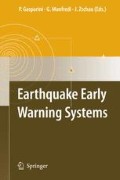Abstract
It has been argued that the dominant period T p derived from the initial seconds of a seismogram, hence only depending on the initial phases of earthquake rupture, seems to scale with the final size of the earthquake. We provide a physical interpretation for the observed scaling and explain how the final earthquake size could be controlled by the initial phase of rupture.
Access this chapter
Tax calculation will be finalised at checkout
Purchases are for personal use only
Preview
Unable to display preview. Download preview PDF.
References
Aki K (1979) Characterization of barriers on an earthquake fault. J Geophys Res 84:6140–6148
Aki K, Richards P (2002) Quantitative Seismology. University Science Books
Barenblat GI (1959) The formation of equilibrium cracks during brittle fracture: General ideas and hypothesis, axially symmetric cracks. J Appl Math Mech 23:434–444
Bouchon M (1979) Predictability of ground displacement and velocity near an earthquake fault: the Parkfield earthquake of 1966. J Geophys Res 84:6149–6156
Broberg KB (1999) Cracks and Fracture. Academic Press, London
Dunham EM, Archuleta RJ (2005) Near-source ground motion from steady state dynamic rupture pulses. Geophys Res Lett 32:L03302, doi:10.1029/2004GL021793
Feder (1992) An introduction to fractal geometry. University Press
Freund LB (1979) The mechanics of dynamic shear crack propagation. J Geophys Res 84:2199–2209
Griffith AA (1921) The phenomena of rupture and flow of solids. Phil Trans Roy Soc London 221:163–198
Heaton T (1990) Evidence for and implications of self-healing pulses of slip in earthquake rupture. Phys Earth and Planet Int 64:1–20
Ida Y (1973) Cohesive force across he tip of a longitudinal shear crack and Griffith’s specific surface energy. J Geophys Res 77:3796–3805
Irwin (1957) Analysis of stresses and strains near the end of a crack traversing a plate. Jour Appl Mech Trans ASME 79:361–364
Nielsen, Madariaga (2003) On the self-healing fracture pulse. Bull Seismol Soc Am
Olson EL, Allen RM (2005) The deterministic nature of earthquake rupture. Nature 438:212–215, doi:10.1038/nature04214
Rice JR, Sammis CG, Parsons R (2005) Off-Fault Secondary Failure Induced by a Dynamic Slip Pulse. Bulletin of the Seismological Society of America 95(1):109134, doi: 10.1785/0120030166
Allen RM, Kanamori H (2003) The Potential for Earthquake Early Warning in Southern California. Science 300:786–789
Yoffe EH (1951) The moving Griffith crack. Phil Mag 42:739–750
Author information
Authors and Affiliations
Editor information
Editors and Affiliations
Rights and permissions
Copyright information
© 2007 Springer-Verlag Berlin Heidelberg
About this chapter
Cite this chapter
Nielsen, S. (2007). Can Earthquake Size be Controlled by the Initial Seconds of Rupture?. In: Gasparini, P., Manfredi, G., Zschau, J. (eds) Earthquake Early Warning Systems. Springer, Berlin, Heidelberg. https://doi.org/10.1007/978-3-540-72241-0_2
Download citation
DOI: https://doi.org/10.1007/978-3-540-72241-0_2
Publisher Name: Springer, Berlin, Heidelberg
Print ISBN: 978-3-540-72240-3
Online ISBN: 978-3-540-72241-0
eBook Packages: Earth and Environmental ScienceEarth and Environmental Science (R0)

